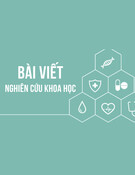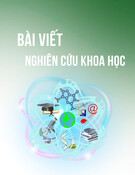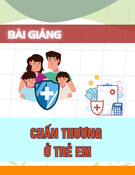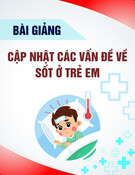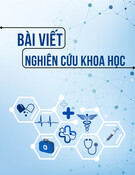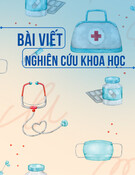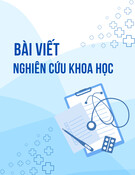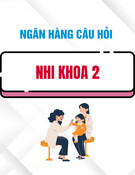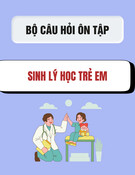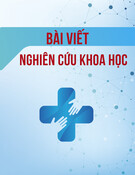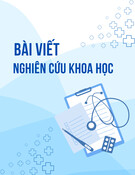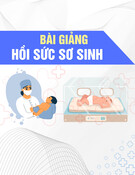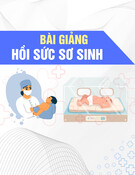
vietnam medical journal n01 - DECEMBER - 2024
244
107877-107885. doi: 10.18632/ oncotarget.14112.
PMID: 29296209; PMCID: PMC5746111
2. Köbel M, Kalloger SE, Boyd N, McKinney S,
Mehl E, Palmer C, Leung S, Bowen NJ,
Ionescu DN, Rajput A, Prentice LM, Miller D,
Santos J, Swenerton K, Gilks CB, Huntsman
D. Ovarian carcinoma subtypes are different
diseases: implications for biomarker studies. PLoS
Med. 2008 Dec 2;5(12):e232. doi: 10.1371/
journal.pmed.0050232. PMID: 19053170; PMCID:
PMC2592352
3. Mayr D, Diebold J. Grading of ovarian
carcinomas. Int J Gynecol Pathol. 2000 Oct;19(4):
348-53. doi: 10.1097/00004347-200010000-
00009. PMID: 11109164
4. Rambau PF, Vierkant RA, Intermaggio MP,
Kelemen LE et al. Association of p16 expression
with prognosis varies across ovarian carcinoma
histotypes: an Ovarian Tumor Tissue Analysis
consortium study. J Pathol Clin Res. 2018 Oct;
4(4):250-261. doi: 10.1002/cjp2.109. Epub 2018
Sep 21. PMID: 30062862; PMCID: PMC6174617
5. Sallum LF, Andrade L, Ramalho S, Ferracini
AC, de Andrade Natal R, Brito ABC, et al.
WT1, p53 and p16 expression in the diagnosis of
low- and high-grade serous ovarian carcinomas
and their relation to prognosis. Oncotarget.
2018;9(22):15818-27
6. Sato Y, Shimamoto T, Amada S, Asada Y,
Hayashi T. Prognostic value of histologic grading
of ovarian carcinomas. Int J Gynecol Pathol. 2003
Jan;22(1):52-6. doi: 10.1097/00004347-
200301000-00011. PMID: 12496698
7. Silverberg SG. Histopathologic grading of
ovarian carcinoma: a review and proposal. Int J
Gynecol Pathol. 2000 Jan;19(1):7-15. doi:
10.1097/00004347-200001000-00003. PMID:
10638449
ĐẶC ĐIỂM VÀ MỘT SỐ YẾU TỐ NGUY CƠ GÂY NHIỄM KHUẨN
TIẾT NIỆU Ở TRẺ TỪ 2 THÁNG ĐẾN 15 TUỔI
TẠI BỆNH VIỆN TRUNG ƯƠNG THÁI NGUYÊN
Nguyễn Thị Tuyết Minh1, Khổng Thị Ngọc Mai2
TM TT59
Mục tiêu: Mô tả đặc điểm lâm sàng và một số
yếu tố nguy cơ gây nhiễm khuẩn tiết niệu (NKTN) ở
trẻ từ 2 tháng đến 15 tuổi tại Trung tâm Nhi khoa,
Bệnh viện Trung ương Thái Nguyên năm 2023 - 2024.
Đối tượng: 139 bệnh nhân từ 2 tháng đến 15 tuổi
được chẩn đoán nhiễm khuẩn tiết niệu điều trị nội trú
tại Trung tâm Nhi khoa, Bệnh viện Trung ương Thái
Nguyên và 278 bệnh nhân tương đồng về tuổi, giới
tính, có triệu chứng sốt với nhóm bệnh theo tỉ lệ
bệnh: chứng là 1:2. Phương pháp: Nghiên cứu mô
tả cắt ngang kết hợp với nghiên cứu bệnh chứng. Kết
quả và kết luận: Tỷ lệ NKTN gặp ở nữ 70,5% cao
hơn nam 29,5%. Tuổi mắc bệnh hay gặp nhất là
nhóm < 2 tuổi chiếm 47,5%. Triệu chứng lâm sàng
hay gặp nhất là sốt cao ≥38,5°C (91,4%), thường gặp
sốt cao kèm rét run ở trẻ lớn hoặc kích thích quấy
khóc ở trẻ nhỏ chiếm 79,1%, triệu chứng rối loạn tiểu
tiện ít gặp 15.8%, các triệu chứng của cơ quan bị
bệnh kèm theo gặp tương đối nhiều là triệu chứng cơ
quan tiêu hoá 45,2%, triệu chứng cơ quan hô hấp
28,1%. Các yếu tố đóng bỉm ở nữ, đái dầm, uống ít
nước, suy dinh dưỡng vừa và nặng, hẹp bao quy đầu,
dị dạng tiết niệu, nhiễm trùng đường hô hấp dưới và
táo bón là các yếu tố nguy cơ có ý nghĩa khi phân tích
đơn biến. Khi phân tích đa biến chỉ có yếu tố suy dinh
1Trường Đại hc Y Dược – Đại hc Thái Nguyên
2Bệnh viện Trung ương Thái Nguyên
Chịu trách nhiệm chính: Nguyễn Thị Tuyết Minh
Email: tuyetminh0396@gmail.com
Ngày nhận bài: 10.9.2024
Ngày phản biện khoa hc: 21.10.2024
Ngày duyệt bài: 22.11.2024
dưỡng nặng là yếu tố làm tăng nguy cơ mắc NKTN
(OR = 2,65, 95%CI = 1,08 - 6,55).
Từ khoá:
Nhiễm
khuẩn tiết niệu ở trẻ em, yếu tố nguy cơ
SUMMARY
CLINICAL CHARACTERISTICS AND SOME RISK
FACTORS FOR URINARY TRACT INFECTIONS IN
CHILDREN AGED 2 MONTHS TO 15 YEARS AT
THAI NGUYEN CENTRAL HOSPITAL
Objectives: Describing the clinical characteristics
and some risk factors for urinary tract infections (UTI)
in children aged 2 months to 15 years old at the
Pediatric Center, Thai Nguyen National Hospital during
2023-2024. Subjects: 139 patients aged 2 months to
15 years old diagnosed with urinary tract infections
treated as inpatients at the Pediatric Center, Thai
Nguyen National Hospital and 278 patients of similar
age, gender, symptoms of fever with disease group
according to case-control ratio of 1:2. Methods:
Cross-sectional descriptive study combined with case-
control study. Results and conclusion: The
frequency of UTI in female is 70.5% higher than in
male 29.5%. The most common age group with the
disease is the group < 2 years old, accounting for
47.5%. The common clinical symptom is high fever ≥
38.5°C (91.4%), often high fever with chills in older
children or irritability and crying in young children
accounting for 79.1%. Urinary disorders symptoms are
uncommon at 15.8%, unurinary symptoms are
relatively numerous include gastrointestinal symptoms
are 45.2%, and respiratory symptoms are 28.1%.
Factors such as diaper wearing in female, enuresis,
drinking less water, severe and moderate malnutrition,
phimosis, urinary malformations, lower respiratory
tract infections and constipation were statistically














